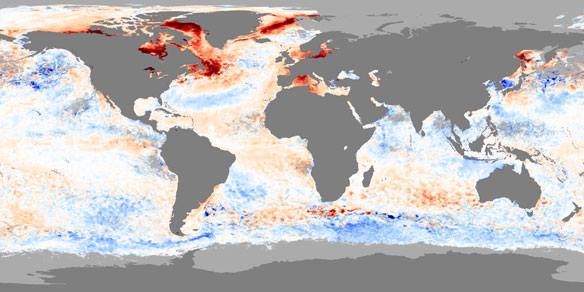
Off the coast of Oregon, a large dead zone—an area of water where the oxygen concentration is so low that little to no marine life can survive—has been appearing each summer since 2002.
NASA
Excerpts;
A report issued September 3rd, by key environmental and scientific federal agencies, assesses the increasing prevalence of low-oxygen “dead zones” in U.S. coastal waters and outlines a series of research and policy steps that could help reverse the decades-long trend.
The interagency report notes that incidents of hypoxia, a condition in which oxygen levels drop so low that fish and other animals are stressed or killed, have increased nearly 30-fold since 1960. Incidents of hypoxia were documented in nearly 50 percent of the 647 waterways assessed for the new report, including the Gulf of Mexico, home to one of the largest such zones in the world.
The impact of the BP Deepwater Horizon oil spill on oxygen levels in the Gulf of Mexico was not considered in this report because the spill had not yet occurred at the time the report was completed. Only additional research will reveal how the presence of oil in the gulf is affecting the large dead zone that forms every summer to the west of the Mississippi delta (see fact sheet), the more than 100 other independent sites along the Gulf of Mexico coast that experience low-oxygen problems, and areas of naturally-occurring deepwater oxygen depletion…
Read Full Article, United States Environmental Protection Agency, EPA
Dead Zones or Hypoxic areas Worldwide, NASA
The cause of anoxic bottom waters is fairly simple: the organic matter produced by phytoplankton at the surface of the ocean (in the euphotic zone) sinks to the bottom (the benthic zone), where it is subject to breakdown by the action of bacteria, a process known as bacterial respiration. The problem is, while phytoplankton use carbon dioxide and produce oxygen during photosynthesis, bacteria use oxygen and give off carbon dioxide during respiration. The oxygen used by bacteria is the oxygen dissolved in the water, and that’s the same oxygen that all of the other oxygen-respiring animals on the bottom (crabs, clams, shrimp, and a host of mud-loving creatures) and swimming in the water (zooplankton, fish) require for life to continue.
The dead zones are areas in the ocean where it appears that phytoplankton productivity has been enhanced, or natural water flow has been restricted, leading to increasing bottom water anoxia.









